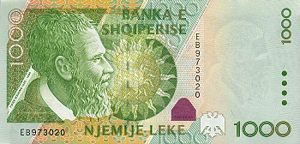Pjetër Bogdani

Pjetër Bogdani ( Italian Pietro Bogdano , * around 1630 in Gur i Hasit near Kukës , † December 1689 in Priština ) was Bishop of Shkodra and Archbishop of Skopje and an important author of early Albanian literature . His book Cuneus Prophetarum , written in 1685, is the first significant prose work in Albanian .
Life
Pjetër Bogdani's family belonged to the narrow elite of the Catholic Albanians. The young Bogdani received his first training in the Franciscan monastery of Tschiprowzi in northwestern Bulgaria. He later studied at the Illyrian Seminary in Loreto in Italy. From 1651 to 1654 he worked as a parish priest in the northern Albanian lectern , after which he studied until 1656 at the seminary of the Propaganda Congregation in Rome, where he earned his doctorate in both philosophy and theology.
On March 6, 1656 he was appointed Bishop of Shkodra and Administrator of the Archdiocese of Antivari . In Shkodra he worked as bishop until 1677 , the administration of Antivari he provided until 1671. Bogdani had to leave Shkodra during the Austro-Turkish war . As the head of the Albanian Catholics, he was not unjustly regarded as a sympathizer of the Habsburgs. From 1664 to 1669 he lived in the villages of Barbullush and Rjoll near Shkodra.
On November 8, 1677, he succeeded his uncle Andrea Bogdani as Archbishop of Skopje. His anti-Turkish stance, his high office in the Catholic Church and not least because he was the spearhead of the Christian rebellion in Kosovo in 1690, Pjetër Bogdani had to flee from the Ottoman rulers to Ragusa . From there he went to Venice and Padua for some time . In Padua Bogdani was kindly received by Cardinal Gregorio Barbarigo , in whose service he had been 22 years earlier. Cardinal Barbarigo was responsible for the affairs of the Catholic Church in the countries of the East at the Curia , and he was interested in the cultures of the Balkans and the Levant . Therefore, he also promoted Bogdani's literary activity and financed the printing of his works.
After Bogdani had his main work Cuneus Prophetarum printed in Padua, he returned to the Balkans in March 1686. There he was committed to the uprising of the Christian residents against Ottoman rule. When the Austrian army reached Kosovo in the Great Turkish War in 1689 , he brought in several thousand Albanian volunteers who took part in the conquest of Prizren. In December 1689 Bogdani died of illness in Pristina and was buried in the local Great Mosque , which was converted into a church. His grave was later destroyed by Ottoman soldiers and the bones dumped on the street.
Cuneus Prophetarum
The Cuneus Prophetarum (Eng. "The Host of Prophets") is a theological treatise consisting of two parts. The first part is based on texts from the Old Testament, the second deals with the life of Jesus. First, Bogdani deals with the creation of man. This is followed by a long section on prophecy, to which the work owes its title. The focus is on the prophets of the Bible, alongside the predictions of various pagan sibyls are included in verse form , which, according to Bogdani's presentation, also point to the coming of the Messiah. The individual chapters of the New Testament section deal with various aspects of Christ's work: his life, his miracles, death on the cross, the resurrection and the second coming at the end of time. Attached is a short section from the Book of Daniel in eight different languages and a brief family history of the Bogdani.
Pjetër Bogdani had already brought the Albanian manuscript of his book with him to Padua . Presumably so that the papal censors could check it more easily, the Congregation De Propaganda Fide requested an Italian translation before going to press. Bogdani worked on this in 1685. Ultimately, his book was printed in two languages, with the two versions side by side in columns. The long parallel text is an important source for Albanology to this day . For the Albanian text, Bogdani used the Latin alphabet, to which he added a few Cyrillic letters for special sounds in his mother tongue. He used the few Albanian-language books by Pjetër Budi , Lekë Matrënga and Frang Bardhi , which were then owned by the Roman Congregation for Propaganda, as linguistic models .
The Cuneus Prophetarum was reprinted in Venice in 1691 and 1702.
literature
swell
- Cvnevs prophetarvm de Christo salvatore mvndi et eivs evangelica veritate, italice et epirotice contexta, et in duas partes diuisa a Petro Bogdano Macedone, Sacr. Congr. de Prop. Fide alvmno, Philosophiae & Sacrae Theologiae Doctore, olim Episcopo Scodrensi & Administratore Antibarensi, nunc vero Archiepiscopo Scvporvm ac totivs regni Serviae Administratore. Patavii 1685. Original edition
- Anila Omari (editor): Cuneus Prophetarum, çeta e profetëve. Akademia e Shkencave e Shqipërisë, Instituti i Gjuhësisë dhe i Letërisë. Tirana 2005. critical edition d. Alb. Academy d. Knowledge
- Oliver Jens Schmitt: Kosovo -Short history of a central Balkan landscape. Böhlau Verlag Vienna 2009
Treatises
- Shefik Osmani: Pjetër Bogdani . Tirana 1996
- Zija Xholi: Pesë mendimtarët më të vjetër të Kulturës sonë kombëtare: M. Barleti, Gj. Buzuku, P. Budi, F. Bardhi, P. Bogdani . Tirana 2003. ISBN 99927-901-1-3
Web links
- Robert Elsie biography
- Edition of the Cuneus Prophetarum
- Entry on Pjetër Bogdani on catholic-hierarchy.org
| personal data | |
|---|---|
| SURNAME | Bogdani, Pjetër |
| BRIEF DESCRIPTION | Bishop of Shkodra and Archbishop of Skopje and author of early Albanian literature |
| DATE OF BIRTH | around 1630 |
| PLACE OF BIRTH | Gur i Hasit at Prizren |
| DATE OF DEATH | December 1689 |
| Place of death | Pristina |
